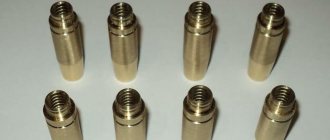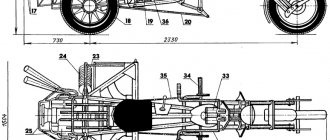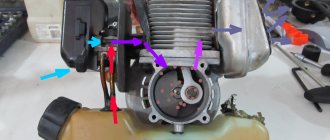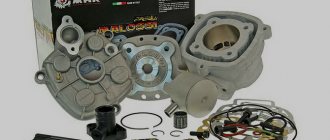Even with minimal tuning of the scooter, you need to think about installing a resonant exhaust . The operating principle and review of saxophones, as such mufflers are popularly called, will be given in another article.
A resonant saxophone muffler is not a cheap thing and not everyone can afford it. Accordingly, scooterists have a desire to save money and make such an exhaust pipe on their own. In this article you will learn how to make a primitive homemade saxophone using the example of a Yamaha Jog scooter. Why primitive? Because with this method we will not carry out calculations of the resonator (this requires a special program), but will simply use a drawing of a saxophone muffler.
How to Make a Yamaha Jog Saxophone Silencer
So let's get started. To make a saxophone, we need metal approximately 1.2 mm thick. It must be cut according to the dimensions indicated on the drawing (You can adjust these dimensions closer to your parameters). In order to accurately bend the metal, we grind a wooden blank to size (we get a kind of wooden muffler) and then bend the steel according to this shape. After carefully adjusting the workpiece, we weld the joints using semi-automatic welding. We clean the part using any available means.
We also bend the muffler and muffler pipe. On one side we weld it completely, and on the other side with rivets (to replace the filler, here it is glass wool). After welding, we check all elements for leaks - there should be no gaps, of course.
We sand all the parts and paint. In this case, the muffler is painted with powder paint, and everything else is painted with simple acrylic paint.
The fastenings on the muffler are made of stainless steel.
And here is the result of our painstaking work - a copy of the Tecnigas saxophone . Not bad, right?
A saxophone on a scooter looks even better .
After installing such a muffler, you may need to adjust the scooter's carburetor, adjust the transmission as a whole, and the engine in general.
Good evening everyone, blog readers... Today there will be an interesting entry, but first of all it will be of interest to those who have mopeds and light motorcycles... Now I will tell you how, without any collective farm work and sawing the muffler and similar things, you can make a pleasant exhaust and a sound that you will like even with Every turn of the throttle, the sound will amaze you more and more... I read a bunch of articles and everything about this, I also watched a bunch of videos of how they cut off the original muffler, drill holes in it, and so on... In short, I am an opponent of such tuning, it’s just stupid... By Therefore, we decided to come up with and create a structure ourselves that will not only be installed, but can be removed... And so, if you are ready, let's begin...
One day I turned to my friend Zelencoff to come up with something to change the exhaust sound to a more pleasant one... I’m just the kind of person who loves a pleasant exhaust sound, I can listen to it for hours. For example, on my car I have a home-made muffler from a GAZelle, completely overcooked and redone as it should, and stuffed with cotton wool that doesn’t burn too tightly... And the result is a pleasant sound, like it’s not a direct flow and there’s not a lot of bass, but it’s pleasant to listen to and doesn’t put pressure on the ears. By the way, it’s also like Ruslan’s idea. So... I got distracted, let's return to our sheep... Phew. to motorcycles. In general, they tried on a bunch of all sorts of pipes, all sorts of cans and bottles and came up with who knows what. then we look at an empty paint can lying around, we sawed off the neck and bottom and just brought it to the muffler and this is what happened...
Alternative options
If you are interested in how to make a muffler quieter without losing precious horsepower, you can use a scheme that has been used in Chinese motorcycles for quite a long time. However, it is worth remembering that this option is only suitable for the production of mufflers for low-power motorcycles, whose performance does not exceed 40 hp. With. A pipe is inserted into the muffler body two-thirds of its length, the last 10 centimeters of which are covered with small holes according to the scheme described above. Having installed the inlet pipe, we are engaged in the outlet, which will be a pipe of a slightly larger diameter, inserted from the opposite side by two-thirds. It also remains to drill holes in 10 centimeters located closest to - such a muffler will represent a compromise between forward flow and the factory product.
If you know the structure of a motorcycle muffler, you can probably make a forward flow from an ordinary part. After opening the housing, you will see tubes that pass through special chambers, first to the end of the muffler, and then back and again to the exhaust pipe. These, as well as the motorcycle's catalytic converter, will need to be removed to achieve the desired effect. The perforated tube mentioned in the previous diagrams is inserted inside and wrapped with fiberglass. Of course, you can buy a special synthetic material used in the packing of original mufflers, but it will obviously cost more.
Two stroke and four stroke scooter
A scooter, as you know, can be with a two-stroke or a four-stroke engine. The operating principle of the entire exhaust system differs radically among analogues.
The muffler on a four-stroke scooter removes gases in a relatively shorter time, doing this with minimal noise. In addition, tuning the muffler in this case will be quite simple. On the other hand, in both cases, when carrying out tuning, it will be necessary to change the pipes.
Types of mufflers for scooters
For the muffler of a two-stroke scooter, selecting components that make it possible to carry out tuning will be much more difficult. The standard muffler itself for such scooters is more difficult to manufacture and configure.
The exhaust system of a two-stroke scooter works as follows. During the process of cleaning exhaust gases, part of the power is returned to the engine. This happens at certain speeds and if you manage to implement this whole process by tuning, the scooter will be unrecognizable.
You can install a high-quality and correctly tuned resonator on a two-stroke scooter. This will give a noticeable increase in dynamics up to a quarter. But in this case, it will be important to carry out professional settings of the entire power system.
Why do you need quality mufflers?
As you know, a certain amount of fuel combustion products accumulates in the cylinders of a moped engine. They must be thrown out and in this case it is the muffler that is responsible for this. In other words, this unit seems to smooth out the pulsations that are inevitable when combustion products are released at high speed.
The very design of the muffler, used not only on scooters and mopeds, but also on motorcycles and cars, implies a special exhaust system, which can be different, depending on what result the vehicle owner wants to achieve. For example, if the desire to improve the gas exhaust system is related to increasing the power of the scooter, a special type of muffler is required - a direct-flow muffler.
EXHAUST SYSTEM DEVICE
With piston valve control, it is impossible to change one of these angles while leaving the other unchanged. Attempts to create motors with asymmetrical phases encounter significant design difficulties. Designers have to apply some compromise solutions to improve cylinder cleaning and reduce losses of fresh mixture. Theory and practice show that gas-dynamic phenomena occurring in the engine gas systems themselves can be used to improve the cleaning and filling processes. The course of processes in the cylinder is influenced by the adjustment of all elements of the engine gas path: the intake system, purge channels, cylinder, exhaust system. (Let us explain that, in principle, tuning means finding such geometric quantities of a particular system that ensure the maximum value of any of the engine indicators, for example, torque at a given speed mode.)
Numerous studies are aimed, in particular, at developing the so-called tuned exhaust system, which makes it possible to achieve an increase in the technical and economic parameters of the engine without excessively complicating the design.
It is clear that any exhaust pipe, especially if it has a small flow area and a large length, slows down the rate of exhaust gases, creating resistance. (From this point of view, the simplest option is the most effective - to make the flow area of the exhaust window as large as possible and to abandon the exhaust pipe altogether, but this path is practically impossible.) Research in recent years has established that the use of a specially selected - tuned exhaust pipe in a two-stroke engine gives noticeable advantages that cover all aerodynamic losses.
Cleaning the muffler
The cleanliness of the muffler affects the power of the moped
Before you start changing anything in the exhaust system, I would like to give one piece of advice. The power of the scooter is directly affected by the cleanliness of the muffler. If it were possible to see the exhaust in a cross-section of the muffler, the owner of the scooter would be very surprised. After a certain mileage, the scooter's dynamics decrease, and owners begin to look for the reasons for this, finding them in a complete rework of the standard muffler or its replacement.
The reason for the loss of power, meanwhile, may be hidden in the condition of the engine itself. This will help determine the specialist you should contact before tuning. But the most common cause of loss of dynamics is soot that clogs the muffler. In this case, it is recommended to carry out cleaning in three ways.
First method: mechanical
It involves cleaning the muffler section (it is done with a grinder). The inside of the muffler is cleaned of soot using a wire or cable. The section in the section is closed by welding.
Second method: chemical
It involves pouring water with some kind of cleaner into the muffler. For example, caustic soda is suitable for this purpose. This cleaning has the advantage that the appearance of the muffler will not be affected in any way.
Third method: heat treatment
The muffler is heated either on the scooter with a blowtorch, or dismantled in an oven or on a grill. It will be necessary to repaint the muffler only after it has cooled.
Muffler conversion
As a rule, many craftsmen not only assemble a muffler, but remake a standard one. This makes it possible to spend less time and get a more acceptable option.
Tools and materials
Before you start tuning, you need to prepare the necessary tools. In this case, the following components will be needed:
- Welding machine, preferably with different operating modes;
- Pipe of appropriate size and diameter;
- Bulgarian;
- Several metal brushes for washing dishes.
Making a direct-flow muffler from scratch
You can make such a muffler from scratch. This will be a completely new version made from several components. The difficulty of this operation, called tuning from scratch, lies in finding the diagram of the exhaust system of a particular moped.
Tools and materials
In this case, again, you need to prepare the necessary tools and materials.
- Purchase in a store or find two pipes with a diameter of 33 mm;
- Buy plexiglass;
- Bolts M8 and M3;
- Prepare glue and nails;
- Welding machine;
- Needles;
- Hacksaw for metal.
Let's start assembling
First of all, you need to cut 18 cm from one of the pipes. It is recommended to carefully process the place in the cut with a needle file. From the second pipe we cut a circle with a diameter of 1.5 cm. We process it using the method described above. Glue the cut out circle in the section of the first pipe. We cut off another piece of pipe, 18 cm long. We make many holes in it. This can also be done with a sharp nail.
We connect all the parts using a welding machine. We fill the cavity formed at the junction of two pieces of pipe with mineral wool. We wrap the finished product with a special fire-resistant material. The homemade muffler is ready. To install it, you will need to attach the element to the scooter body mount.
Making a muffler mounting element
From plexiglass, which is indispensable in this matter due to its strength and easy paintability, we cut out a special type of ring, the edges of which can be bent outward by 180 degrees. We attach the resulting circles with serifs to the moped using the required bolts. We polish the muffler using sandpaper. To be sure, the joints between the homemade product and the moped body will need to be lubricated.
Homemade muffler for moped disassembled
If homemade production causes certain difficulties, you can find a lot of models of mufflers already in finished form. They are usually inexpensive. On the other hand, only a homemade version can provide the ideally expected option.
Stage 5.
Assembly.
From the very beginning, the design of the muffler seemed dismountable to me. I thought there would be 3 parts, but settled on two. The first assembly and launch were experimental, so the fastening of all the parts was not major - it was simply secured with a couple of welding points. I made a clamp for the mesh from a pipe of a suitable diameter and welded it tightly. On the other hand, the mesh is also fixed with a pipe, which is also our outlet. We insert the mesh inside. We fill the space between it and the muffler body with fiberglass material. The packing is done quite tightly. As practice has shown, if the packing is loose, the insides of the muffler fly out very quickly. The first launch must be carried out outdoors, as many small particles of fiberglass will be released into the air, which are very harmful if inhaled. During final assembly, we completely clean the muffler body, degrease it and paint it with special heat-resistant paint.










